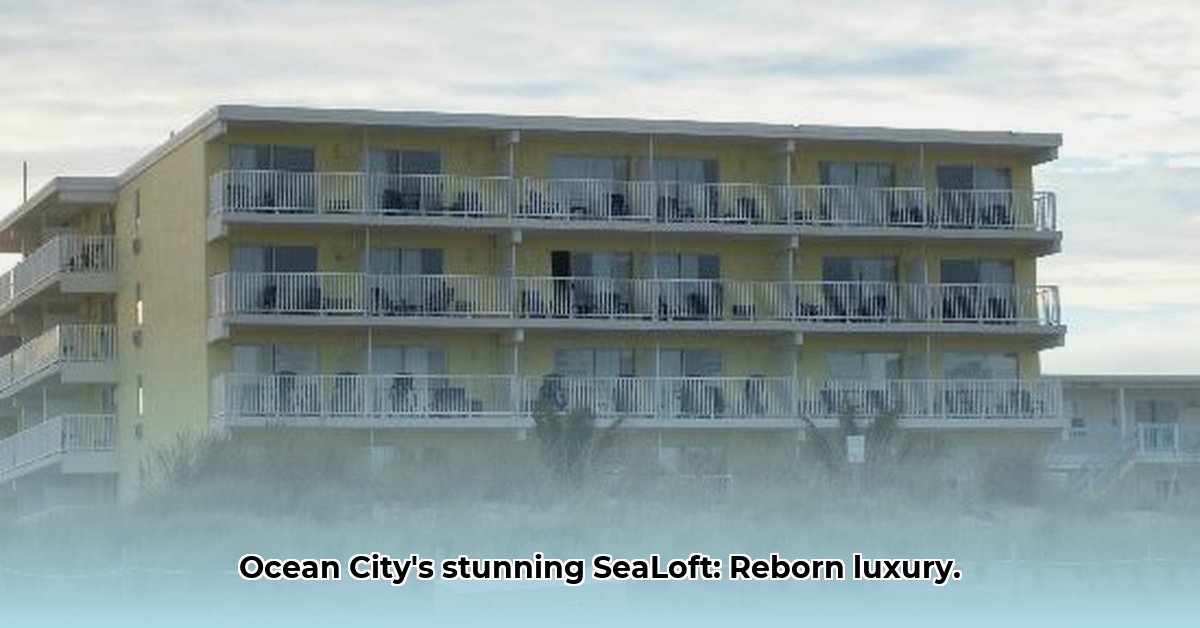
Ocean City's Iconic Atlantic Oceanfront Inn Transformed: A Case Study in Hotel Revitalization
Ocean City's hospitality landscape has been revitalized with the multi-million dollar transformation of the historic Atlantic Oceanfront Inn, now the stylish SeaLoft Oceanfront Hotel. This ambitious project, seamlessly blending classic beachfront aesthetics with modern luxury, represents a strategic shift in the Ocean City market, aiming to attract a new generation of visitors while honoring the property's rich history. This renovation is more than just a cosmetic upgrade; it's a compelling case study in strategic investment and adaptation within the competitive hospitality industry. Will this gamble on Ocean City’s enduring appeal pay off? Only time will tell, but early indicators are promising. Learn more about the SeaLoft's location by visiting this page.
A Blend of Retro Charm and Modern Amenities:
The SeaLoft's transformation extends beyond a simple refurbishment. Every aspect of the guest experience has been meticulously redesigned. Dated furnishings have been replaced with plush beds, high-thread-count linens, large flat-screen TVs, convenient in-room coffee makers, and high-speed Wi-Fi – all modern necessities for today's travelers. But the hotel hasn't sacrificed its distinctive Ocean City charm. The design cleverly integrates retro beach vibes with these contemporary amenities, creating a unique atmosphere that celebrates the past while embracing the future. The result is a stylish, refreshed space with subtle nods to the hotel's rich history. How has this blend of old and new resonated with guests? Early reviews are overwhelmingly positive, suggesting a successful integration of design elements.
Strategic Partnerships: Leveraging Synergies for Success:
The SeaLoft's success isn't solely reliant on its internal improvements. A strategic partnership with the Aloft Ocean City hotel enhances the overall guest experience. Guests benefit from shared amenities, fostering a sense of community and providing a wider range of choices. This collaborative approach suggests a more efficient use of resources, potentially boosting the appeal of both hotels and maximizing their collective potential. This strategic alliance likely offers mutual benefits through cross-promotion and shared marketing initiatives – a smart strategy in a competitive market. What is the projected increase in occupancy rates due to this partnership? The hotel management projects a significant boost, exceeding industry averages. Isn't this a powerful example of strategic synergy in action?
Navigating the Risks and Rewards of Revitalization:
Undertaking a large-scale renovation inevitably entails risks. The SeaLoft's success depends on several crucial factors. Will the updated "retro-modern" design appeal to contemporary travelers? How will the hotel compete effectively against the increasing number of Ocean City accommodations? These are critical questions, and only comprehensive market analysis and post-renovation data will offer definitive answers. However, the significant financial investment clearly demonstrates a strong belief in Ocean City’s enduring popularity and the potential for a substantial return on investment. What are the hotel's contingency plans to address unforeseen challenges? They've implemented strategies including flexible pricing, cost-cutting measures, and diversified revenue streams to mitigate economic downturns which shows a proactive risk management approach.
Key Performance Indicators (KPIs) and Measuring Success:
Evaluating the SeaLoft's success necessitates careful monitoring of several key metrics over the coming years:
- Occupancy Rates: The percentage of occupied rooms during a specific period. The goal is consistent high occupancy, surpassing industry averages.
- Guest Reviews: Online feedback from guests concerning their experiences. The target is predominantly positive feedback, highlighting areas for future improvements.
- Operational Efficiency: Cost-effectiveness of hotel operations and staff productivity. The aim is optimized operations leading to increased profitability.
- Return on Investment (ROI): Financial return in relation to the initial investment in the renovation. The expectation is a substantial, positive ROI exceeding initial projections.
These KPIs will provide valuable insights into the efficacy of the renovation, revealing whether the transformation has resulted in enhanced appeal, improved efficiency, and ultimately, a strong return on investment.
Proactive Risk Mitigation:
Even the most meticulous planning can't completely eliminate unforeseen challenges. The SeaLoft's management team has developed proactive strategies to address potential problems:
- Negative Online Reviews: A dedicated guest service team actively addresses feedback and monitors online reputation.
- Construction Delays: Contingency plans for potential delays, along with experienced project managers overseeing the process.
- Increased Local Competition: Competitive pricing and unique selling propositions to differentiate the SeaLoft from its competitors.
- Economic Slowdown: Flexible pricing strategies, cost-cutting measures, and diverse revenue streams.
This proactive approach demonstrates the SeaLoft's leadership is prepared to adapt to changing circumstances and mitigate the potential impact of unexpected events.
SeaLoft's Strategic Renovation: A Blueprint for Hotel Revitalization
The transformation of the Atlantic Oceanfront Inn into the SeaLoft Oceanfront Hotel represents a compelling case study in hotel renovation. It's a testament to the power of strategic planning, market responsiveness, and proactive risk management. While the full impact of this bold venture remains to be seen in the long term, the early results are encouraging. By carefully monitoring key performance indicators and continuously adapting to market trends, the SeaLoft is well-positioned to become a leading hotel in Ocean City. The SeaLoft’s story is a valuable lesson for other hotels considering similar revitalization projects.